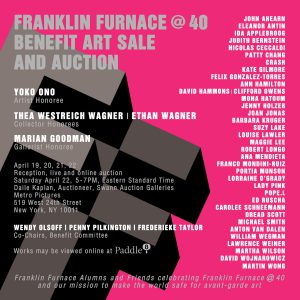Archive for the ‘Contemporary Art’ Category
Zach Blas Contra-Internet at Art in General
Contra-Internet: Jubilee 2033 trailer from Zach Blas on Vimeo.
I had been looking forward to seeing Zach Blas’s Contra-Internet exhibition at Art in General, unfortunately it was not as engaging as I had hoped. The exhibition presents one single channel video installation that features the nearly 30 minute film “Jubilee 2033” and three other single-channel video works on monitors. The three video works on monitors present ideas and research regarding the internet – the hegemonic network of today and for the foreseeable future – through computer screen recordings by Blas. (I really hope that artists stop using screen-recordings of themselves clicking through files as a medium; it’s seldom interesting.)
Although I was disappointed by the exhibition, the gravity dance performance by Cassils as Nootropix, “a contra-sexual, contra internet prophet” is captivating an entirely worth the trip. The premise of the film is funny as it opens with Ayn Rand discussing the future of her ideas with two of her followers – Alan Greenspan and a fictional character Joan Mitchell. A young Greenspan proposes that the group take an acid trip. I was turned off by the highly accented performance of Rand and her cult, so I was glad to see them drop liquid acid.
As the trip begins, an internet connected artificial intelligence in the form of a manga character appears and takes them in to the future. The future is of course dystopian as the present reality burns and it’s certainly fun seeing the Google headquarters burning along with other tech companies in the not so distant future of 2033.
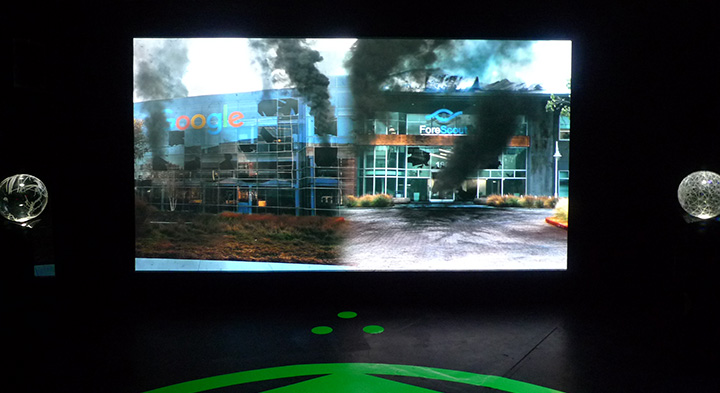
Along their travels, we encounter tech workers being taken hostage by “The Art Professor” wearing gray, paint-splattered coveralls and wielding a machine gun. Later in a classroom, the Art Professor introduces Nootropix (Cassils) who in their monologue states that they will perform the creation of gravity. The performance artist is powerful and their dance upon a purple matrix while dawning a large, erect, glowing CGI penis that is constantly spewing black liquid is awesome. The dance is mesmerizing and triumphant.
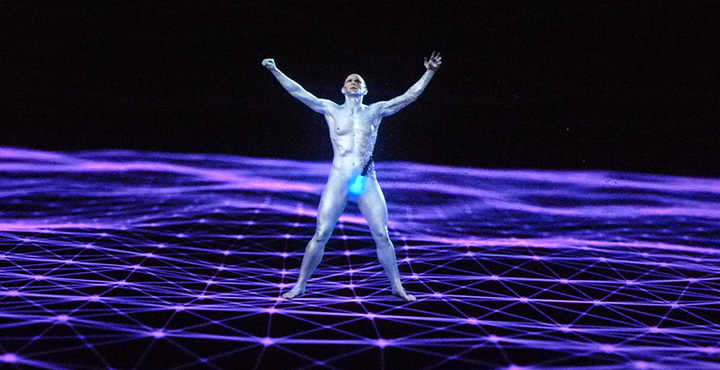
In Nootropix, Blas presents one of his contra-internet exotic creatures “to discover or create a world of network difference.” I could have entirely skipped the storyline, and merely be fantastically transported by Cassils’s character and performance as I think that it would have left me asking more questions and appreciating the mystery. We know that a network of difference is not plausible, so why not create the fantastic and shed the tedious philosophizing.
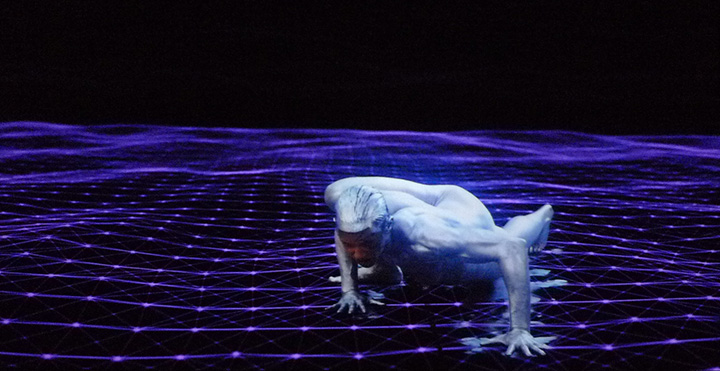
Chelsea Galleries September 2017
There are plenty of strong exhibitions in Chelsea this September into October. And the fancy blue chip galleries are presenting a racial and identity social consciousness as black artists receive recognition at at least a few major galleries. Here are a few that I enjoyed this past weekend.
Sanford Biggers: Selah, Sept 7th through October 21st at Marianne Boesky Gallery.
Kara Walker at Sikkema Jenkins & Co
Mark Thomas Gibson at Fredericks & Freiser through October 14, 2017
Realidad VE
Realidad VE is a small experiment that attempts to combine documentary material with virtual space for VR presentation.
Last fall I had an extended interview with José Bergher a retired professor and classically trained musician from Venezuela who was the director of the Symphony Orchestra of Venezuela. Throughout his professional career he worked between New York City and Caracas and the reason behind the interview was to learn about that dual citizenry – about living between cultures and floating from one part of the world to the other. However as the interview progressed, I asked José about the current state of Venezuela – politically, economically and the common problems that people face day to day. He replied with a 20 minute discussion of the rise of Chavez and the current power-grab by Maduro and the lasting influence of Fidel Castro.
I knew that this discussion would not be appropriate for the project that I was working on, but I appreciate his first-hand perspective and given the last several weeks in Venezuela, I wanted to present his voice in a unique format. Entirely based on my news consumption of current protests, clashes and seemingly general instability in Venezuela, I created a blank world with the exception of dead trees and abandoned drilling rigs. The world is populated by men and women running across the space. A boy sits against a tree taking in the world around him. At another spot a young couple argues and elsewhere two friends are in discussion. Along the entire perimeter paramilitary troops stand guard and watch the space. At a couple spots trios of soldiers have friendly discussions. In this world, the military is at ease, though watchful whereas the people appear frantic.
I’m interested in combining documentary material such as the interview with José Bergher with virtual space and employing virtual reality as a platform for documentary. Jose’s discussion of current Venezuelan politics presented an opportunity for experimentation. Pictured above is the project for installation that features an animated José Bergher above the virtual space, the project is online with out Bergher’s video, only his voice accompanies the virtual space as the inclusion of video made an already long load time much longer.
“Once Upon a Place” at Time Square
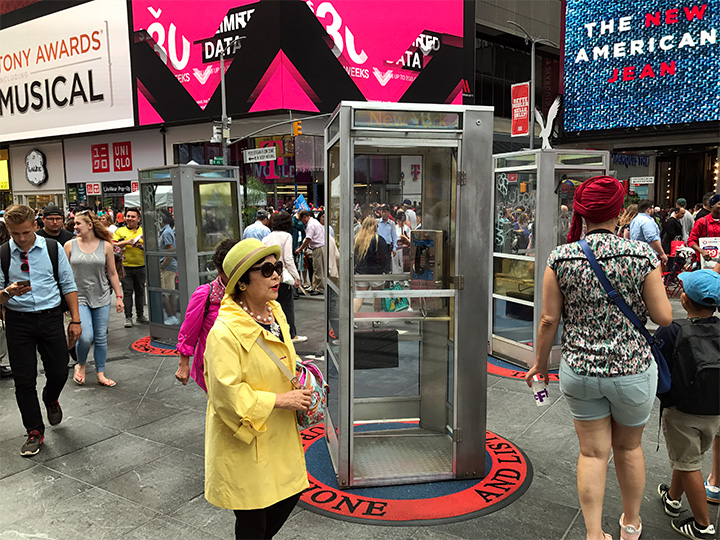
“Once Upon a Place” by Aman Mojadidi at Time Square
Repurposed public phone booths are a poor vehicle for the sharing of immigrant stories. As an artist largely dedicated to reflecting upon migrant populations and cultural dislocation, as soon as I heard about Aman Mojadidi’s “Once Upon a Place”, installed at Time Square, I knew that I needed to visit the project. I worked out a deal with my son and hauled him up to Time Square. Upon entering Duffy Square, we encountered three old phone booths sitting on red and blue carpets with phrases such as “Global Stories” along the circular perimeter.
The first one I entered did not appear to function. I picked up the receiver, put it to my ear and heard only silence. I searched for instructions on the phone as I pushed the numerical keypad, nothing. I pulled out the phone book hanging below a steel shelf, but there was no information as to how to activate the phone. I considered putting coins in the slot, but didn’t have any. So then I stepped out, and read the signage for the project, still no instructions. At this point, the other phones were empty so I tried a second phone booth.
Upon putting the receiver to my ear, I heard the voice of a woman. She was from Mexico and she was describing the hardships and poverty of her home town. The story was brief. She was followed by a man from West Africa, I do not recall the country. He has well explained his desire for a new life due to the intense poverty of his upbringing. The next man, if I recall correctly was Dominican and he explained how his entire family had immigrated to the United States. He was left alone in his country, so he felt that he had little choice but to migrate to the United States…
I believe that the reason that I don’t recall details from these personal stories, besides the fact that it was hot and uncomfortable in the phone booth, is that they were not very interesting. The use of the repurposed phone booth to share immigrant tales is clever (though I don’t recall and can’t imagine a phone booth ever being a popular means to call family across borders), but the framing and presentation of the content does not make the work compelling. Ultimately, the work relies on the strength of the subjects the artist has captured and the artist’s capability to steer the conversation or interview and stir nuance from the subject. The three subjects (of 70) that I listened to were not engaging story tellers. Their experiences were sad and clearly state the need to escape a harsh reality and yet they did not summon empathy or any emotional reaction in me.
However, my time with the project was cut short, by a bored nine year old, who started tapping down the phone’s hookswitch and with each tap the voice from the receiver would go silent. The recording would not pause as when he lifted the hookswitch and I heard the voice again, it did not begin from the stopping point, but rather the audio was continual. So once we were both frustrated, I relented to his desire to move on.
We sat in the stands over looking Duffy Square and ate lunch. I continued to observe the installation. Sadly there was very little interest in the project from the throngs of tourists on a summer Saturday afternoon as the phone booths remained largely empty. Occasionally a curious tourist would poke her head in, listen for a few seconds and then walk out.
My take away from interacting with the installation and observing the public interest: a multitude of stories or interviews, apparently a total of 70, does not generate an interesting project. A single compelling story teller is more significant than many interviewees. Secondly, I found the combination of the immediate surroundings and the heat within the phone booth too distracting to focus on the audio for very long. Time Square is not a good location for audio installations that rely upon focused engagement. Lastly, I’ve got to stop taking my son to see art work that I wish to engage with for any extended period of time. Perhaps, I’ll go back at night by myself and have a different experience.
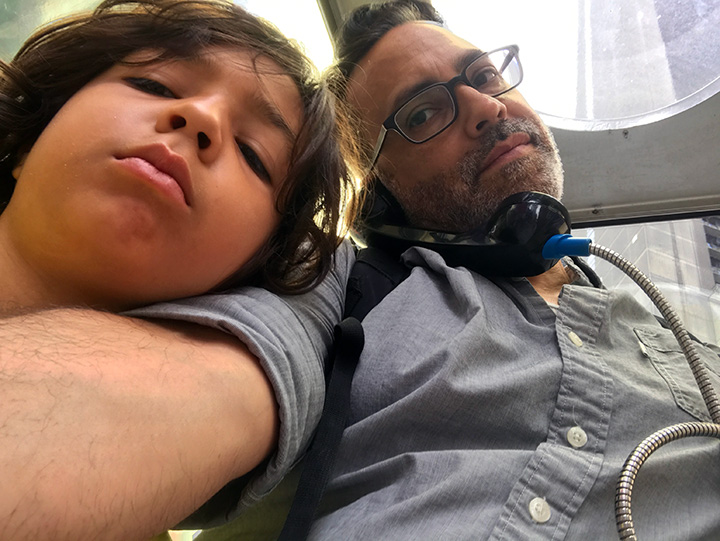
Sharing the phone at Aman Mojadidi’s “Once Upon A Place”
The installation commissioned by Time Square Arts will continue to be available until September 5th at Duffy Square – West 46th Street and Seventh Avenue.
“Hansel & Gretel” at Park Avenue Armory – Save Your Money

The “Hansel & Gretel” curatorial statement describes the installation as a space that brings together Jacques Herzog, Pierre de Meuron and Ai Weiwei combined interests in
the psychological impact of architecture and the politics of public space; creating a playful, strange, and eventually eerie environment with different layers of reality revealed to the visitor… Hansel & Gretel is a dystopian forest of projected light where the floor rises up, as if lifted by an invisible force, and visitors are tracked by infrared cameras and surveyed by overhead drones as they systematically capture the parkgoers’ data and movements…
Unfortunately, the only portion of this description that resonates is the playfulness. Indeed Herzog, de Meuron and Weiwei have created a dark environment in which visitors may skip around and play with light traces of their image. However, the installation lacks strangeness, eeriness, politics or any psychological reverberation.
Other than the initial moment of discovery that one’s image is being projected on to the ground after it is periodically taken due to on one’s movement in the space, the installation presents very little that is interesting. The drones may have been a neat prop had they not been tethered.
The second part of the installation is a didactic revelation of what the installation is trying to allude to – that we are objects of surveillance. As far as a critical art installation regarding surveillance, there was much more interesting work done 15+ years ago. Perhaps the theme of surveillance has been so overly investigated and picked apart by art previously and by entertainment today (“Black Mirror” for example) that such an installation seems trite and naive. There is so much of our data being captured today, that building an installation that merely plays upon facial recognition and motion sensors is just kind of dumb, but it is playful. So if $16 is worth the cost of running around a huge dark open space and playing with light projection, check it out.
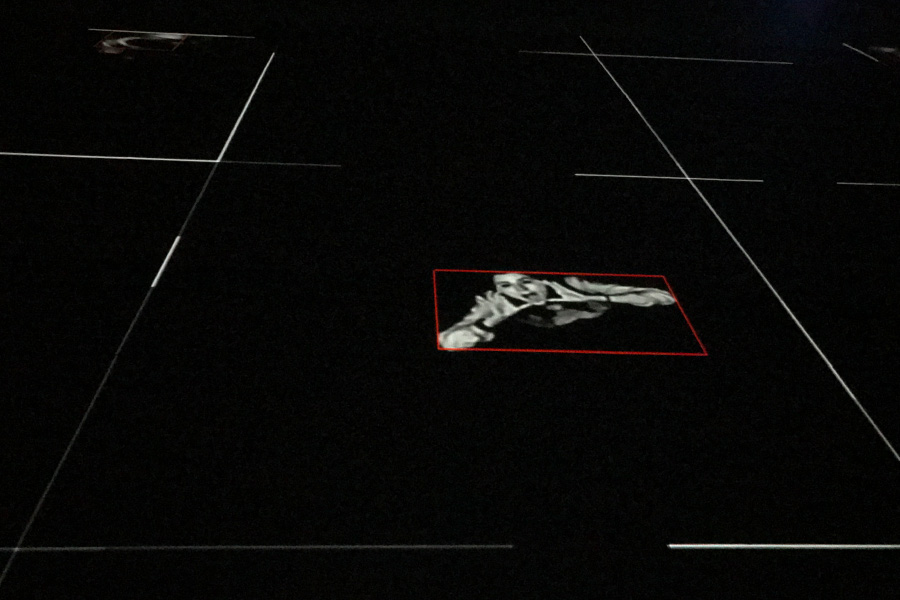
A second perspective: Playtime at the Armory
Once again discovering what this city has to offer, there I was with Ricardo walking into a venue called the Armory near Hunter College, a place I had never been before to see a new art installation called “Hansel & Gretel”. He had been keen to check this out for a few weeks, and like the curious creature I am, I followed along.
We received a quick intro and were instructed to read a phase on the wall before entering -which i forgot- and then allowed to enter. We walked into black nothingness. My immediate reaction was to scramble for Ricardo’s hand. I didn’t realize the massiveness of this place until my eyes adjusted from the summer sunlight to the darkness inside of the Armory. It was only eerie the first few minutes because I had no idea where the hell I was walking. There were a few cameras far above us hanging from the ceiling and lights that would follow us. As we continued to walk, our movement was detected, grid lines would appear and cameras would be activated to capture our moves. Suddenly, it was playtime! It was fun to pose in different positions to watch the resulting snap shot of yourself illuminated on the black floor. At one point my sweater and shoes came off and I really got into it.
Ricardo noticed two drones hovering on one side of the space living poor unfulfilled lives- tied onto leashes without free movement. It would have been more interesting if they were chasing people around. After exhausting our ideas for poses, the novelty wore off and we were ready to enter part deux of the installation. For that, we had to exit this part of the Armory and enter from another entrance on the other side of the street.
After pausing in front of a camera you were allowed inside. There were many ipads on long tables with apps. You could elect to have your face identified and then search the cameras for your photo which was taken in the first part of the installation. That was cool. You could read about the history of surveillance, or access cameras to spy on others walking into the exhibits. The Armory itself was impressive, the installation not as much. It was a new, interesting experience- a fun activity for kids, I would say. I didn’t leave with the feeling that I had witnessed an impressive statement against today’s constant scrutiny and monitoring that we are all under. I didn’t feel intruded upon. There wasn’t anything menacing or fantastical as is described in the program leaflet. It was just pretty cool and fun.
Perhaps the work behind the installation was complicated, but with my lack of technical know-how, I failed to appreciate the amount of effort involved. To have truly made an impact, more could have been done to confuse or play with the audience with the intention of throwing them off or perhaps even scaring them. Coupling that with the sound of Russian men having conversations in the background (that felt clandestine in nature), and I would have possibly left quite feeling differently.
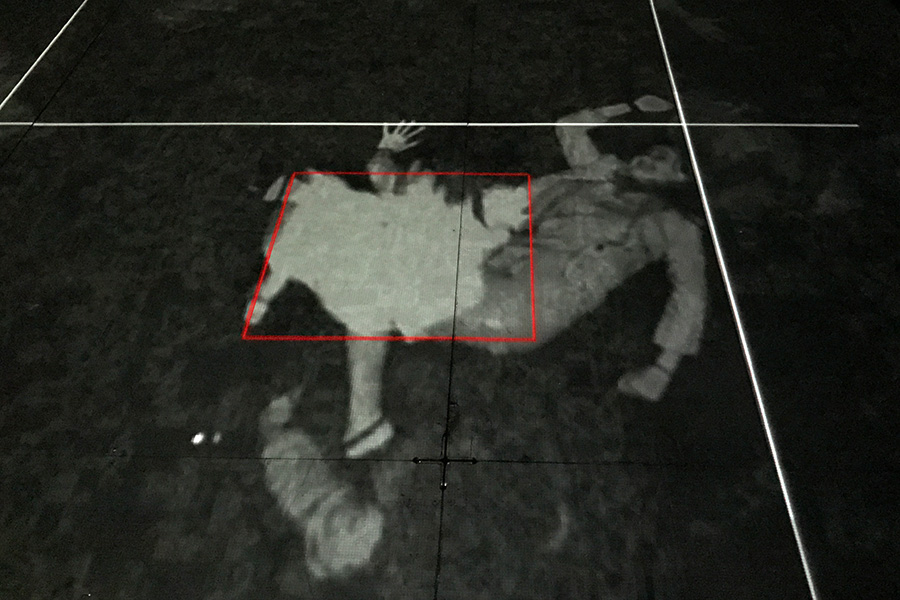
FRANKLIN FURNACE @ 40
Help the Franklin Furnace continue to make the world safe for Avant-Garde Art (the really weird shit that the NEA is afraid of). The Furnace has turned 40 and is now relocated in Pratt Institute, however, in order to re-grant money to artists that challenge the norms of our society, the Furnace needs financial help. Anyone can donate to the Furnace anytime, but at this time the Furnace is holding a benefit art sale and you can participate via Paddle8!
Exhibition, Friday-Saturday April 19-22, 10am-6pm
Reception and Live Auction of Five Works, Saturday April 22, 5-7pm
Metro Pictures, 519 West 24 th Street, New York, NY 10011
FRANKLIN FURNACE @ 40 Honorees
Yoko Ono, Artist
Thea Westreich Wagner & Ethan Wagner, Collectors
Marian Goodman, Gallerist
FRANKLIN FURNACE @ 40 offers for sale original art by:
John Ahearn, Eleanor Antin, Ida Applebroog, Judith Bernstein, Patty Chang, Nicolas Ceccaldi, CRASH, Kate Gilmore, Felix Gonzalez-Torres, Ann Hamilton, David Hammons/Clifford Owens, Mona Hatoum, Jenny Holzer, Joan Jonas, Barbara Kruger, Suzy Lake, Louise Lawler, Maggie Lee, Robert Longo, Ana Mendieta, Franco Mondini-Ruiz, Portia Munson, Lorraine O’Grady, Lady Pink, Pope.L, Ed Ruscha, Carolee Schneemann, Dread Scott, Michael Smith, Anton van Dalen, William Wegman, Lawrence Weiner, Martha Wilson, David Wojnarowicz, Martin Wong.
Fabrica Habana
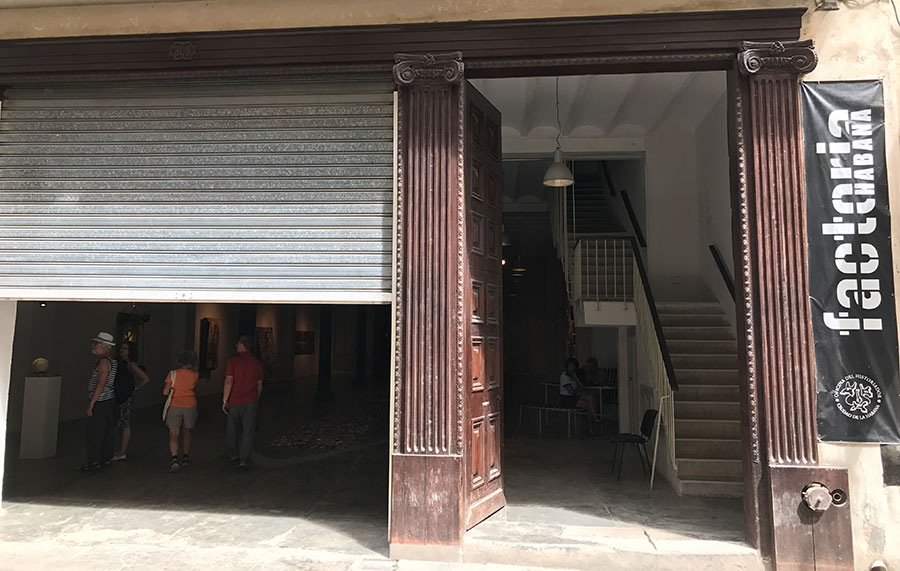
Fabrica Habana, contemporary art gallery of Concha Fontenla, Habana, Cuba
Currently on exhibition at the beautifully renovated colonial home turned contemporary art gallery by Concha Fontenla in Old Habana is a three story exhibition by Cuban artists Jose Toirac and Octavio Cesar Marin. Toirac and Marin draw from various artistic movements such as Conceptual Art and Arte Povera to create a study of the recent history and current reality of Cuba. The gallery consists of three floors and if one begins at the top and works their way down, there is a chronological thread throughout the exhibition. Beginning with allusions to Ancient Western Philosophy and Christianity. On the third floor one will find a broken bronze vase to commemorate Diogenes de Sinope (412-323 BCA), a Greek philosopher of the “escuela cinica” who gave up all material goods and lived as a vagabond on the streets of Athens searching for the honest man.
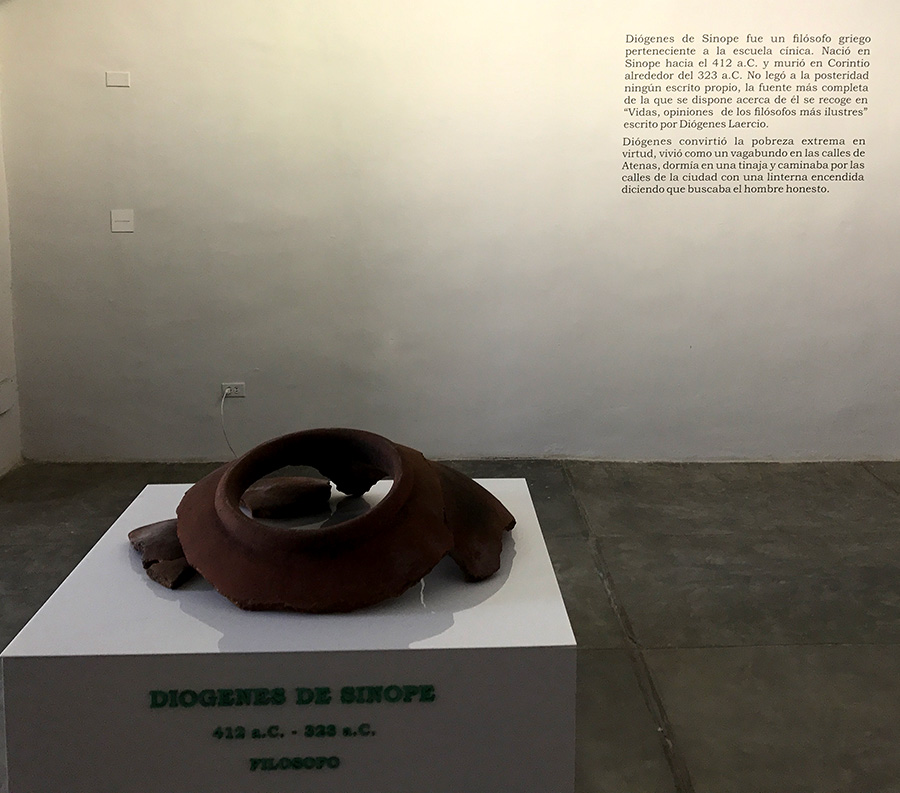
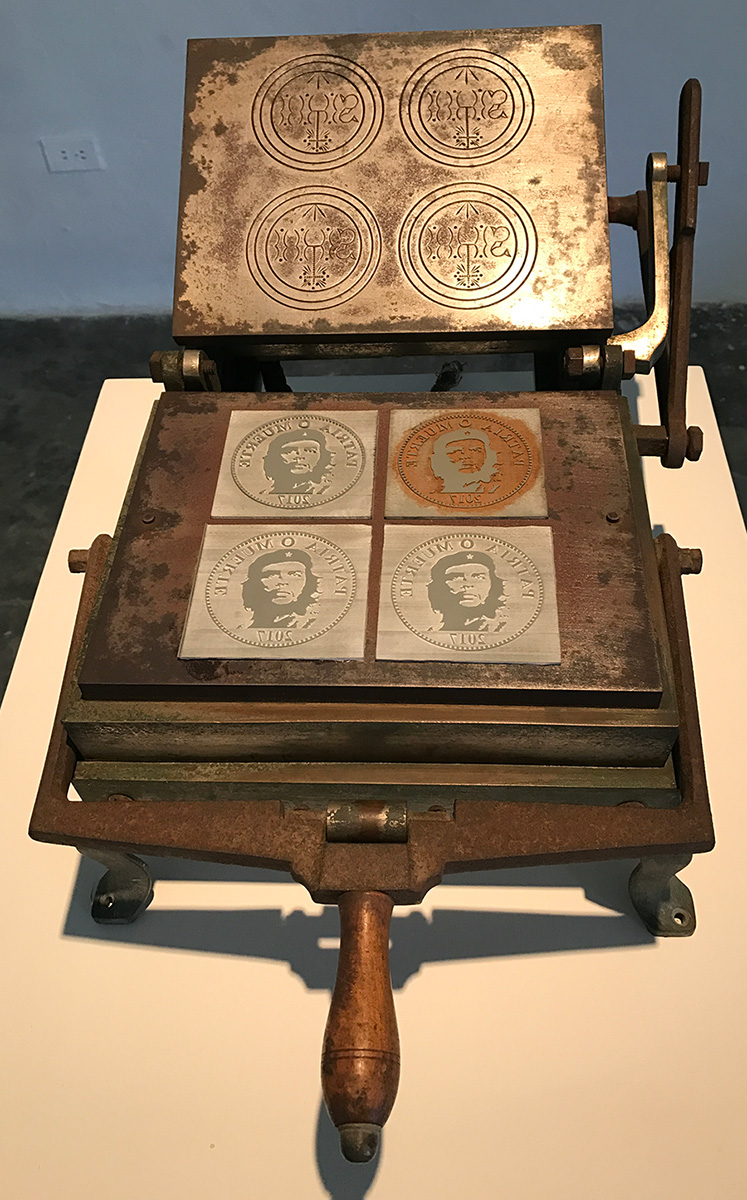
On the same floor, a metal press sits on a pedestal. On one side of the press, is the symbol of christ as stamped on to the eucharist and on the other plate is the portrait of Che Guevara with the phrase “Patria o Muerte 2017”. Above the press is a quote from Fidel, stating that every child should be modeled after Che, an honest and virtuous man. To the right of the press is a long table with two dozen tin cups filled with packaged eucharists stamped with the portrait of the Che. Above the table floats a holy chalice also with the portrait of El Che.
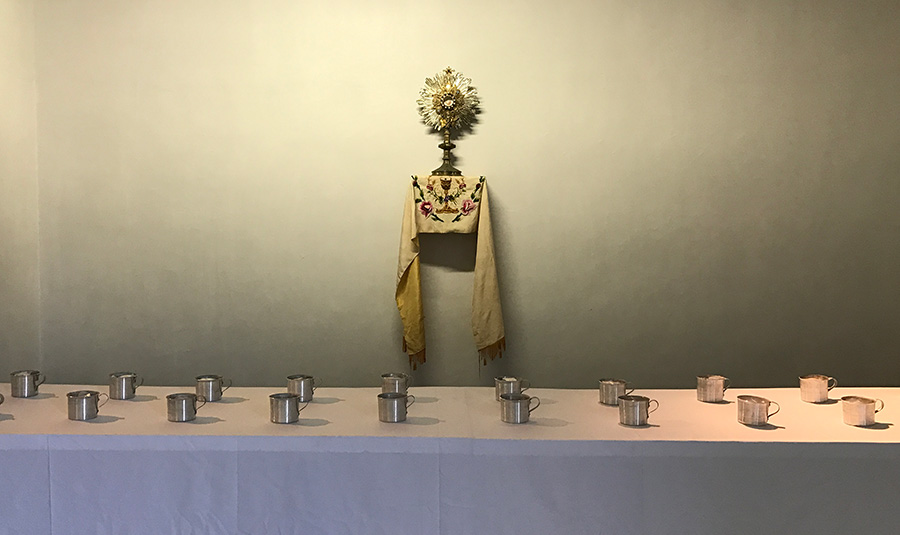
On the second floor one will find many memorials to famous Cubans. Each memorial is a pedestal with the name of the historical figure, the dates of birth and death (if the person has died) and the work that each one is known for and on top of the pedestal are objects commemorating the individual. The memorials include intellectual figures such as Jose Marti as well as business men, a famous cook…
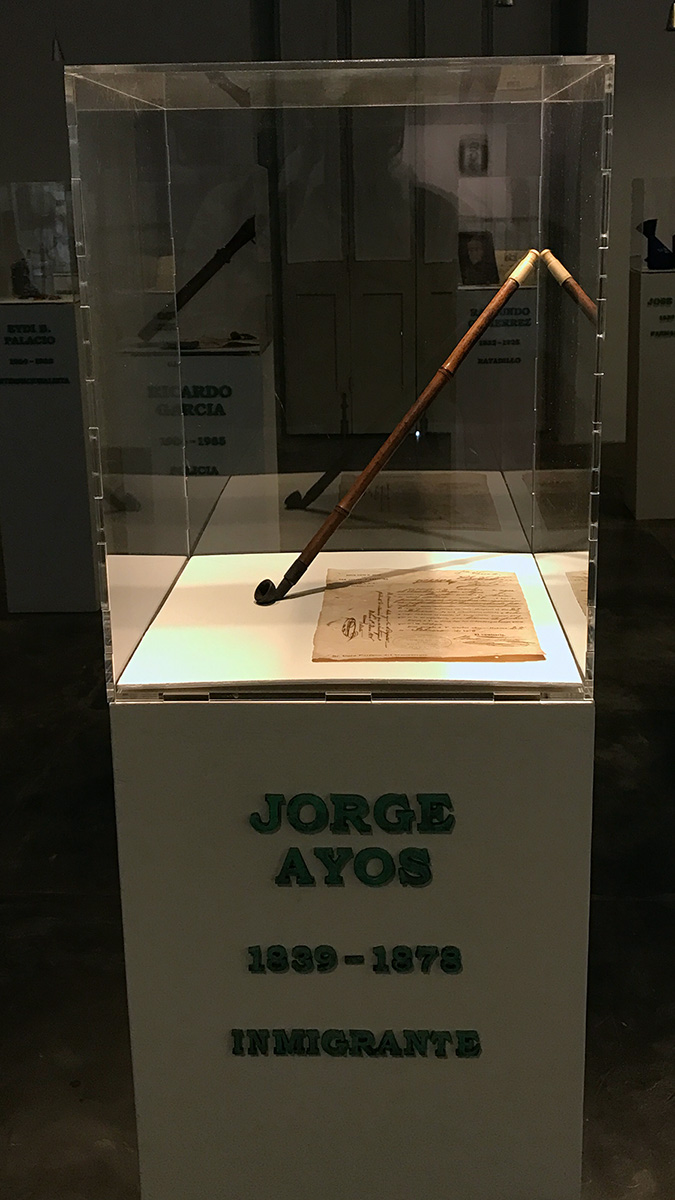
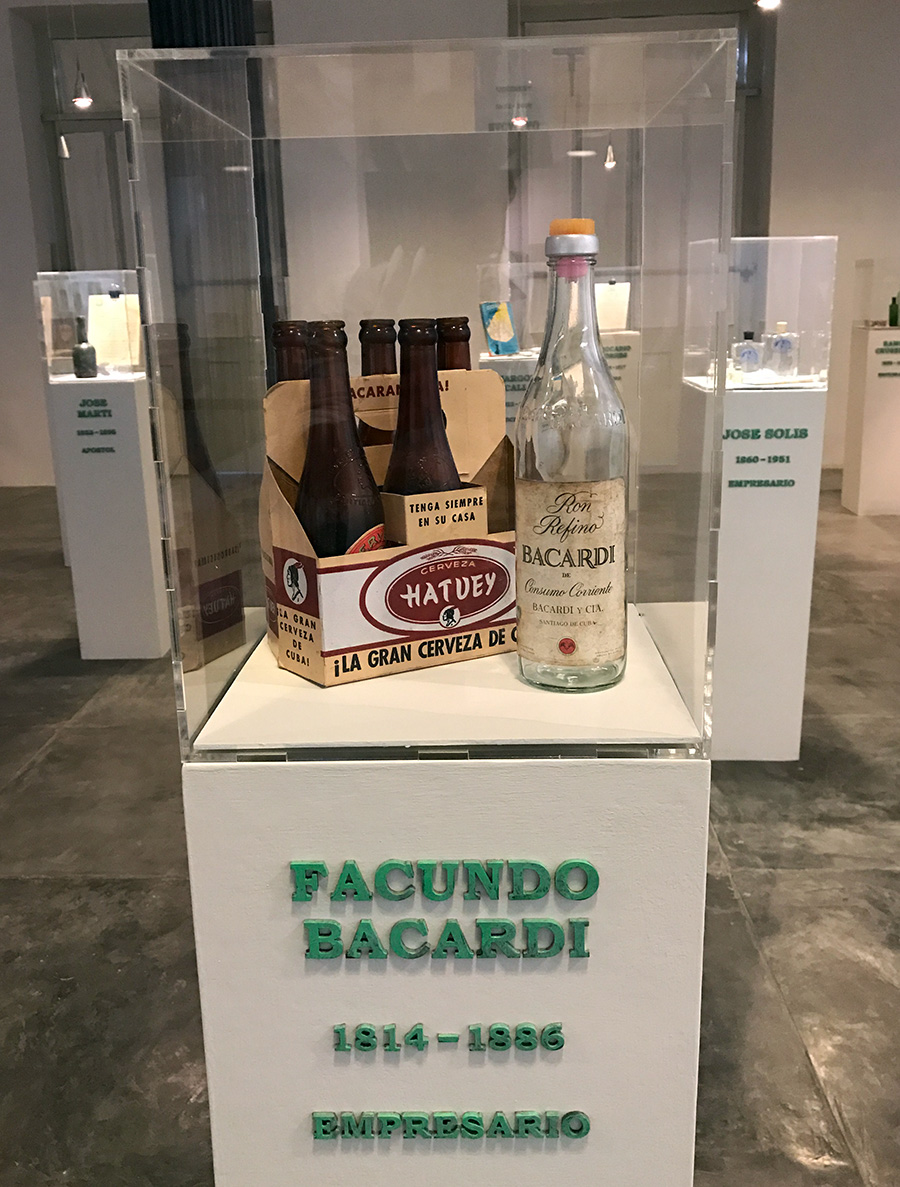
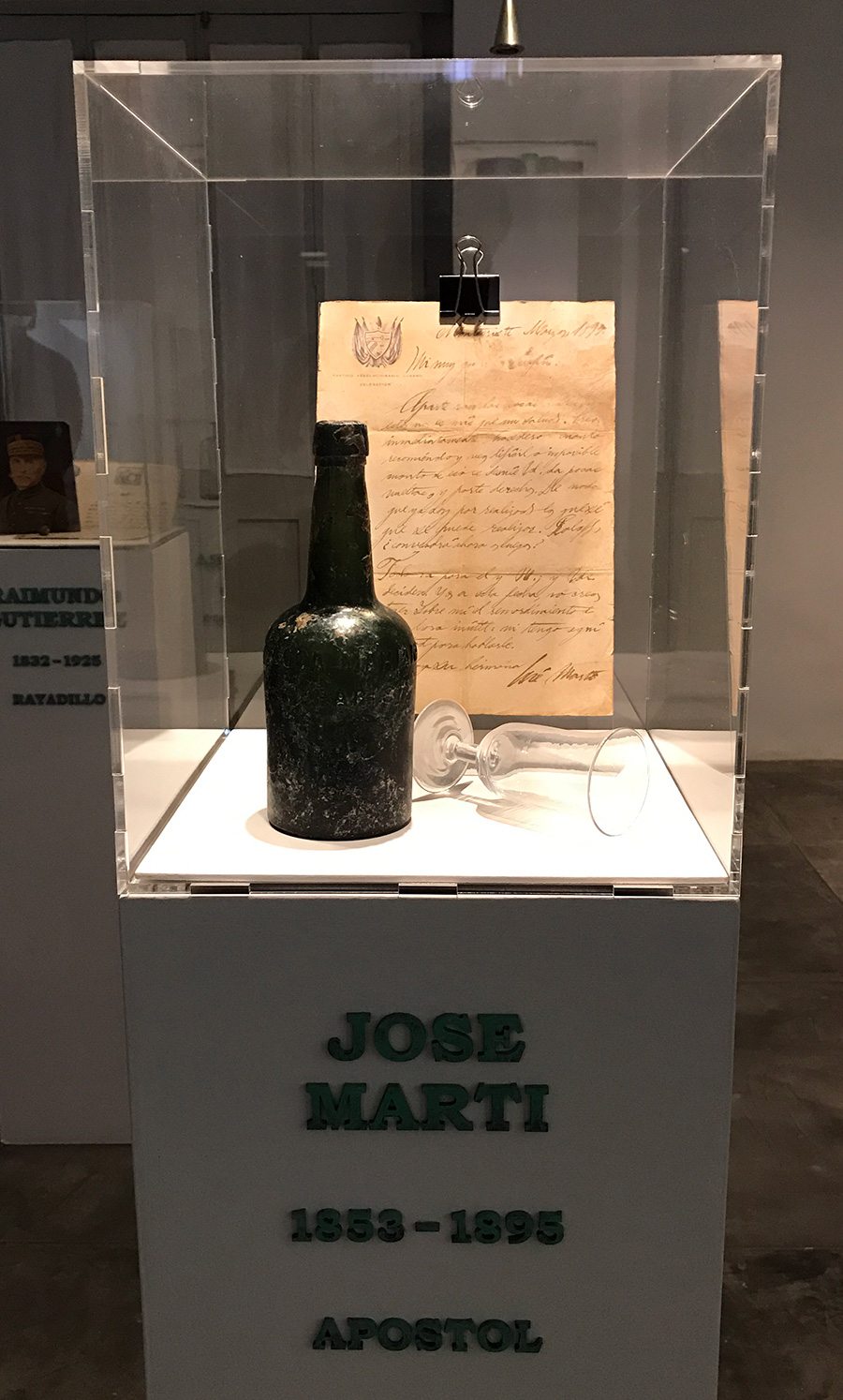
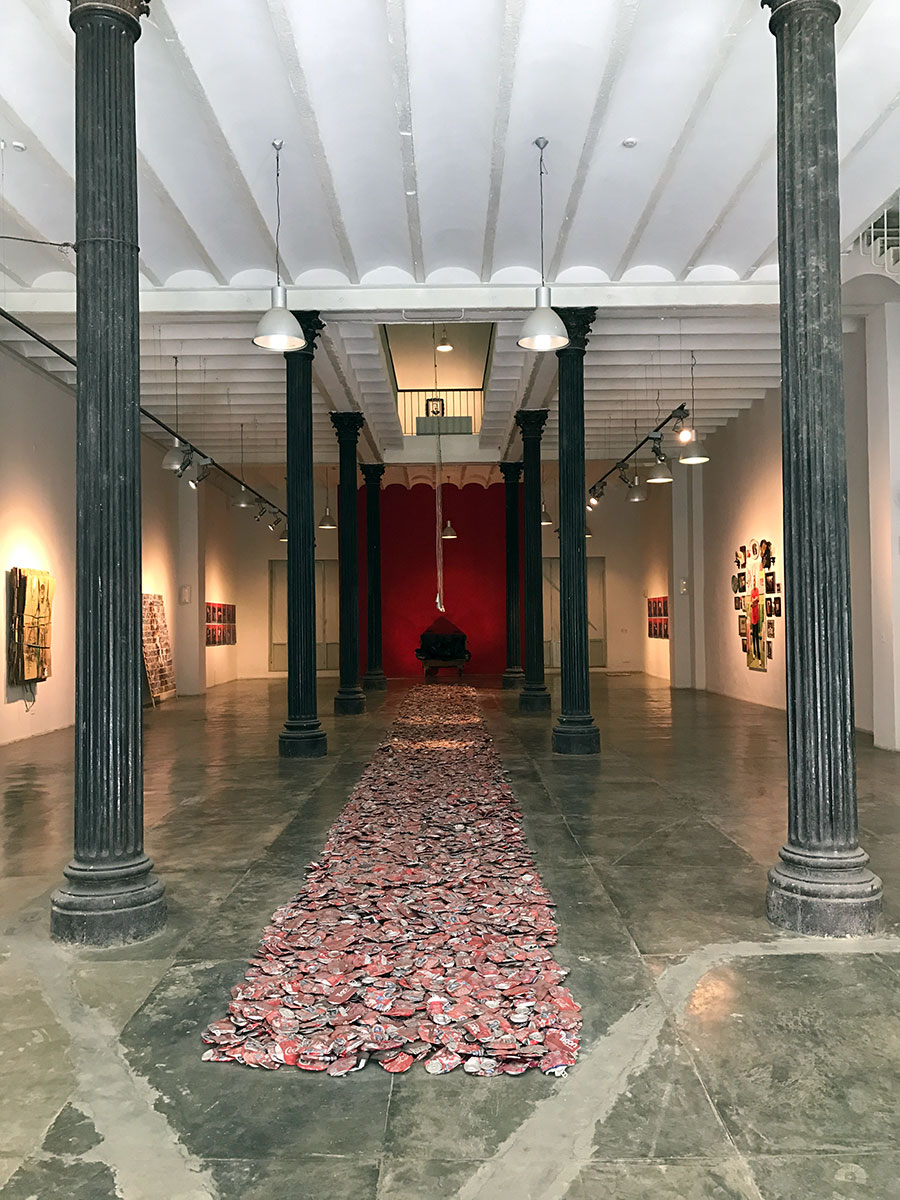 Finally, on the street level, the artists present a red carpet made of flattened tin cans of Cuban beer and soda. And on the three walls of the gallery hang a series of portraits of Cubans today from a street recycler to a flower vendor a famous chef. Each of these portraits are executed on the material or tools of their trade. At the rear of the gallery, are a couple dozen portraits shot on a steel cart with trash bags (that is installed against the rear wall). These portraits seem a bit trite as they try to emulate professional studio portrait images. However the larger portraits are beautifully executed.
Finally, on the street level, the artists present a red carpet made of flattened tin cans of Cuban beer and soda. And on the three walls of the gallery hang a series of portraits of Cubans today from a street recycler to a flower vendor a famous chef. Each of these portraits are executed on the material or tools of their trade. At the rear of the gallery, are a couple dozen portraits shot on a steel cart with trash bags (that is installed against the rear wall). These portraits seem a bit trite as they try to emulate professional studio portrait images. However the larger portraits are beautifully executed.
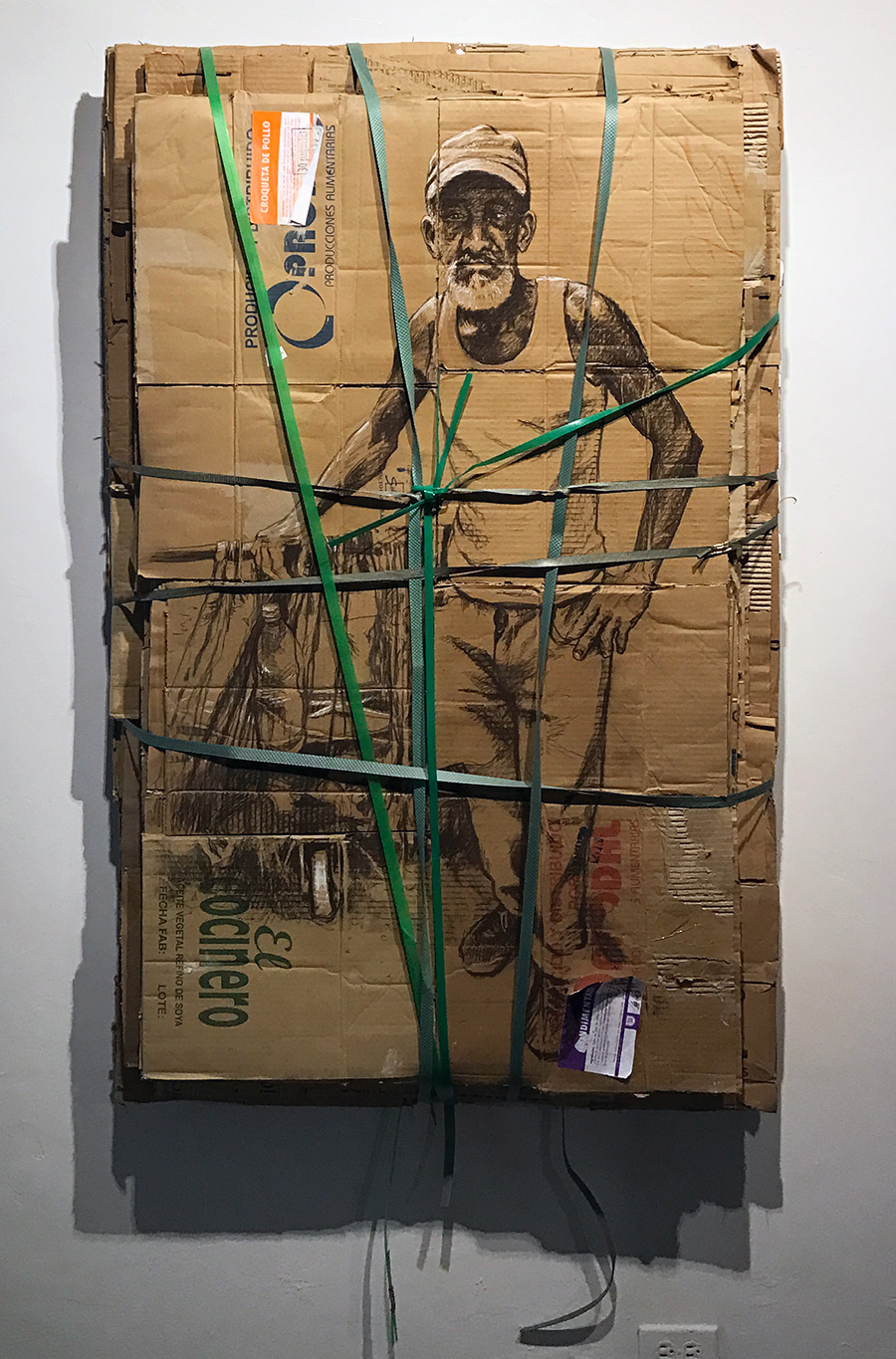
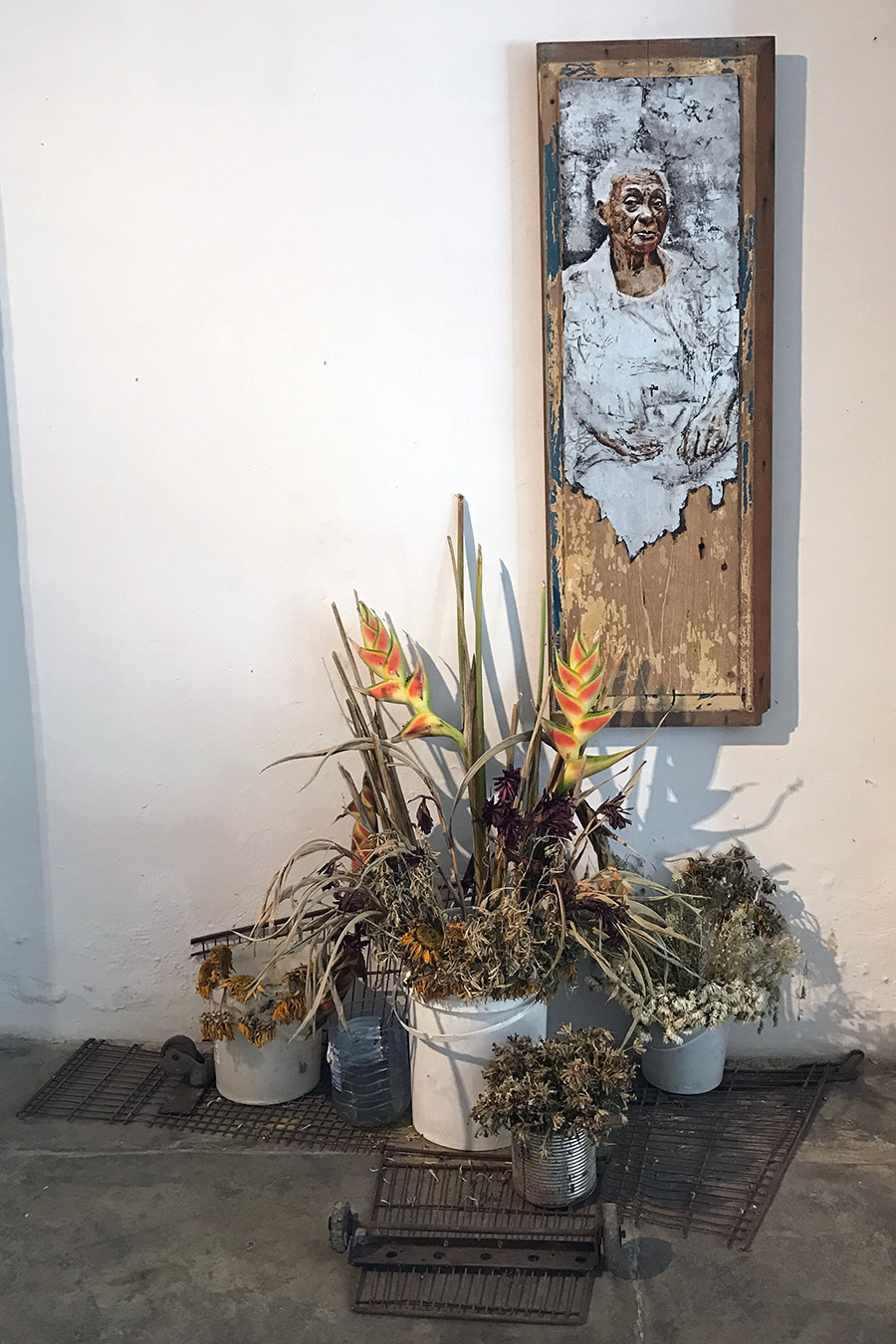
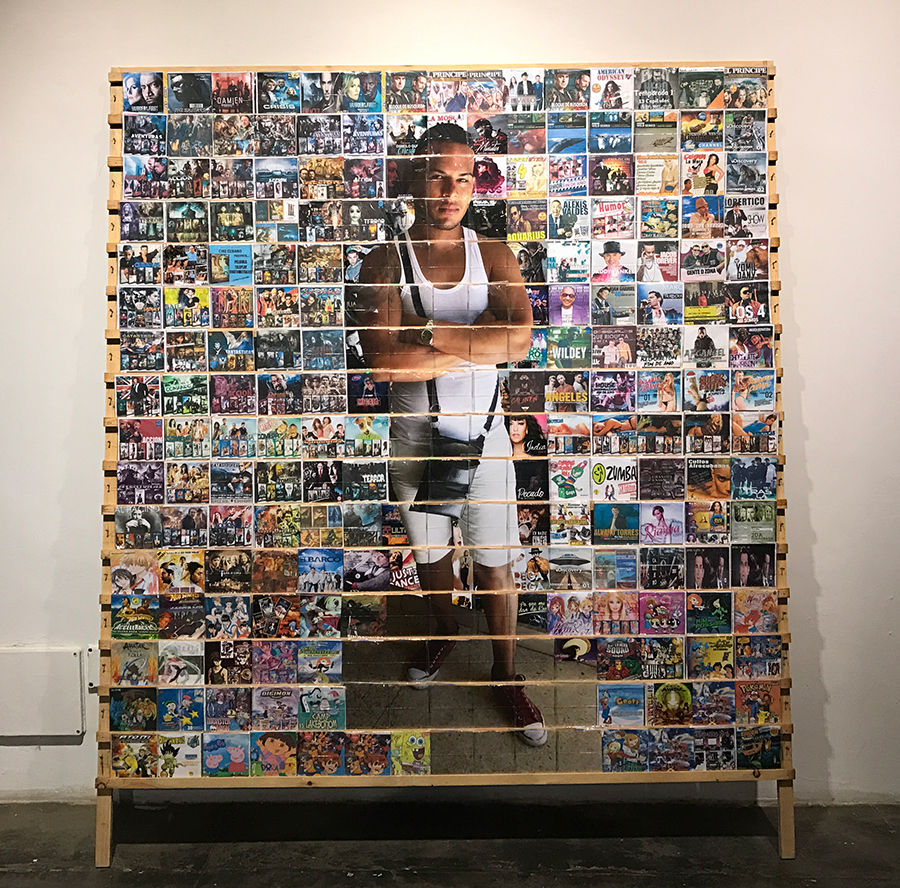
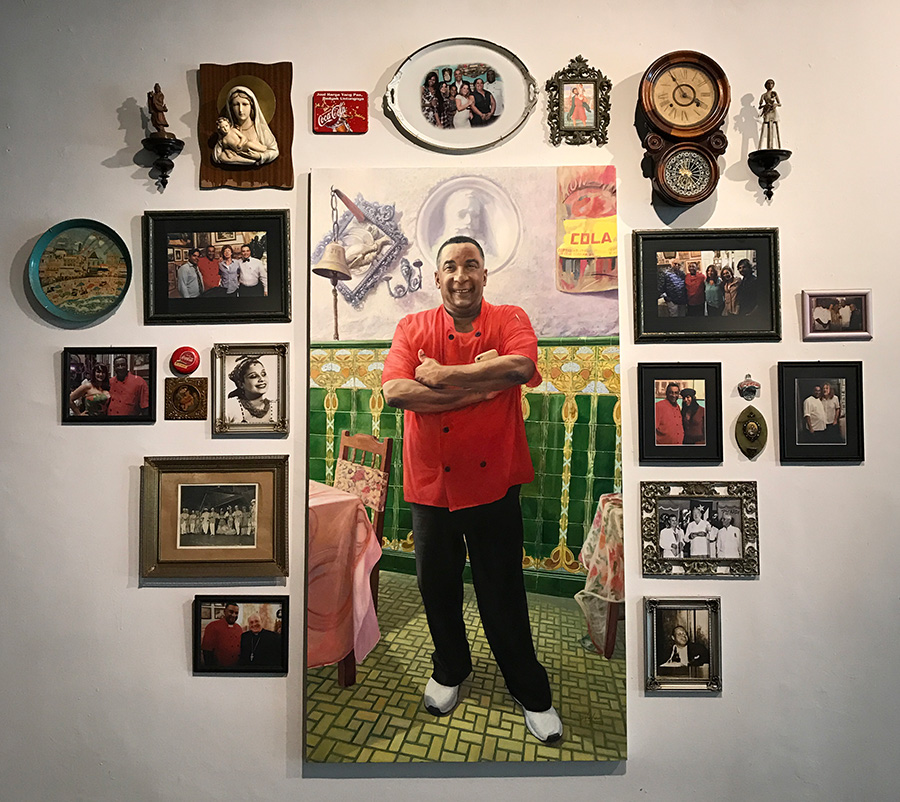
“Broken Bone Bathtub” Review

Broken Bone Bathtub by Siobhan OLoughlin
This past Saturday night a bit before 9pm, I stepped down into a basement apartment in Long Island City, Queens, just a couple blocks from MoMA PS 9. A few weeks ago, I read glowing reviews about Siobhan O’Loughlin’s immersive theater piece Broken Bone Bathtub that occurs in private bathrooms, so I decided to check it out. Once through a small door that I had to duck under, a coat rack outside the apartment entrance received the audience. I went with a friend and we entered behind a young couple who were very excited about the experience. We stepped in to the living room of the apartment and were greeted by a cheery hostess who invited us to chocolate fondue and nuts and a few other appetizers. Red wine was also available, but required a small donation. The hostess, told us about herself, the apartment – voluntarily lent by immersive theater fans and the actress as we waited for the Siobhan to gather herself; this was the second performance of the evening.
A few minutes later, another young woman nodded to the hostess indicating that the actress was ready for us. The hostess asked for two volunteers who would be comfortable speaking and contributing to the piece. Two young women raised their hands and were taken to the bathroom for introductions and instructions. A few minutes later, the remaining four of us, were invited to enter the small bathroom; the audience was a total of six.
Siobhan sat naked in a cast iron bathtub, her breasts concealed by soap bubbles. The two volunteers sat adjacent to the bathtub and the rest of us took seats on a toilet, stool, small chair and small plastic step stool. The actress thanked us for coming asked if we were all comfortable and then began her narrative. Her left arm was in a cast, decorated with signatures and drawings. She told us about the pain and the time necessary to recover from a broken bone and the difficulties of day to day life with her left arm in a cast. She began to detail how the accident happened, riding her bike to an activist meeting along the west side of Prospect Park, headed to Grand Army Plaza. She asked if we were familiar with the area, everybody appeared to be and as I ride it regularly, she asked me to describe it. Following my description of the area, she told us that it was a rainy night and there was a husband and wife riding south as she rode north. It was dark and wet and perhaps the couple had been riding in tandem. She collided with the woman. The husband immediately attended to her wife as Siobhan found herself alone and in a great deal of pain…
Through the performance, topics such as who do we call at a moment of emergency, loneliness, whether or not we cry, were discussed by both the actress and the audience. She seamlessly moved through the responses from audience members back to her narrative. At one point she sang a song as one of the volunteers either scrubbed her back or conditioned her hair. She joked that throughout this period of healing, she borrowed the bathrooms of friends in order to not be alone. And throughout the performance she made sure to include each audience member.
The piece was smart and thought provoking. Unfortunately, the bathroom door was left ajar and at the beginning, the residents of the apartment were taking cell phone photos of us in their bathroom. Later, at times it was distracting to look out to the living room and see people on their devices. However, in general, the manner that Siobhan was able to weave the audiences’s discussion in to her performance was impressive. The one weak element in the piece was unfortunately the conclusion.
Siobhan entered a seemingly heartfelt conclusion, she allowed herself to cry as she discussed moving on from the healing period. The crying and the final monologue felt contrived in comparison to the rest of the performance, because unlike the preceding narrative, it did not engage dialogue, but was instead prescriptive. The uniqueness presented by the back and forth between the actress and each audience was broken and the piece reverted to conventional theater – a one way presentation. It would have been transformative, if each conclusion appeared to vary given the audience interaction. Siobhan could still maintain the underlying message, but it would be great if she was able to draw from what was shared by a given audience to inform the concluding monologue rather than loose the sense of immersion.
Volta Art Fair 2017
Last night, I strolled through the vast Volta13 Art Fair at Pier 90 in Manhattan. For the most part, the fair did not present anything particularly exciting, but below are a few of the works that I considered beautiful and interesting.
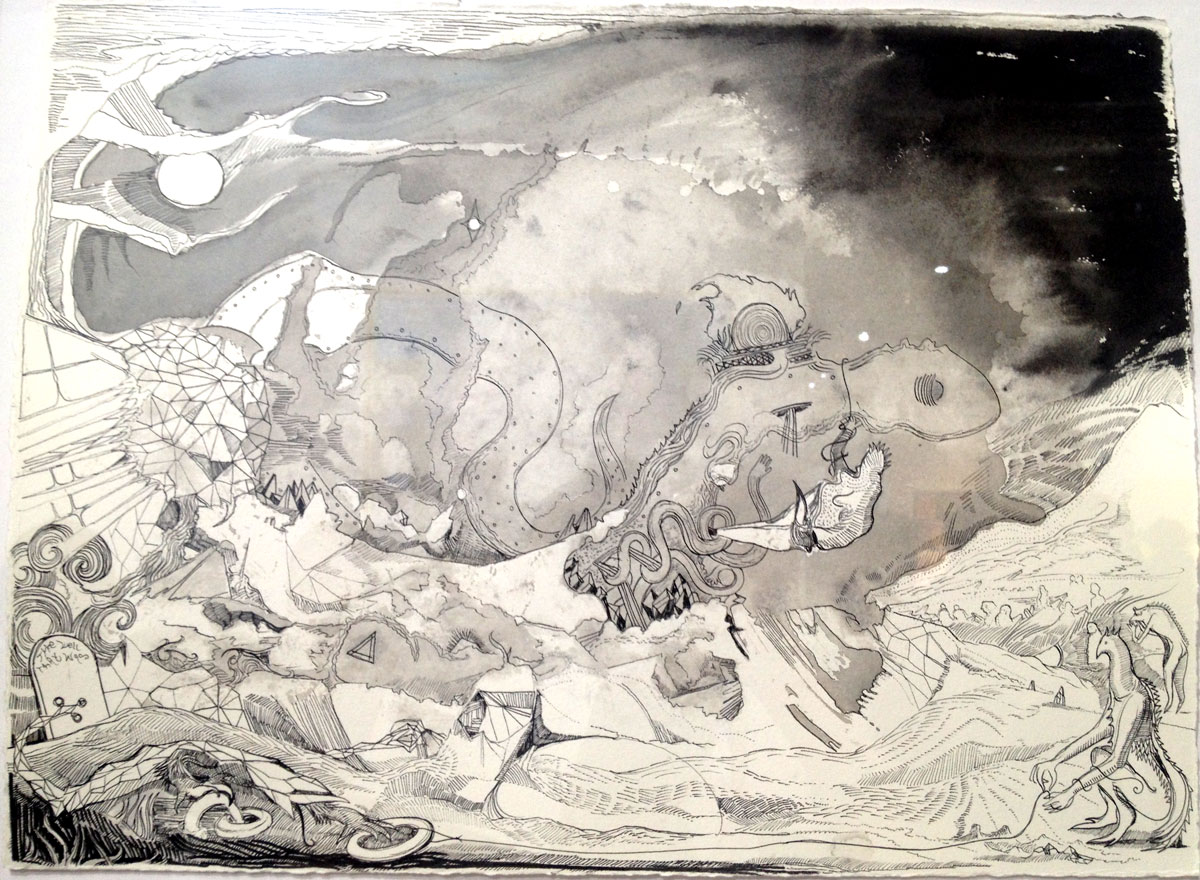
from Max Razdow’s “Metropolis Drawings” that portray “a city in becoming”
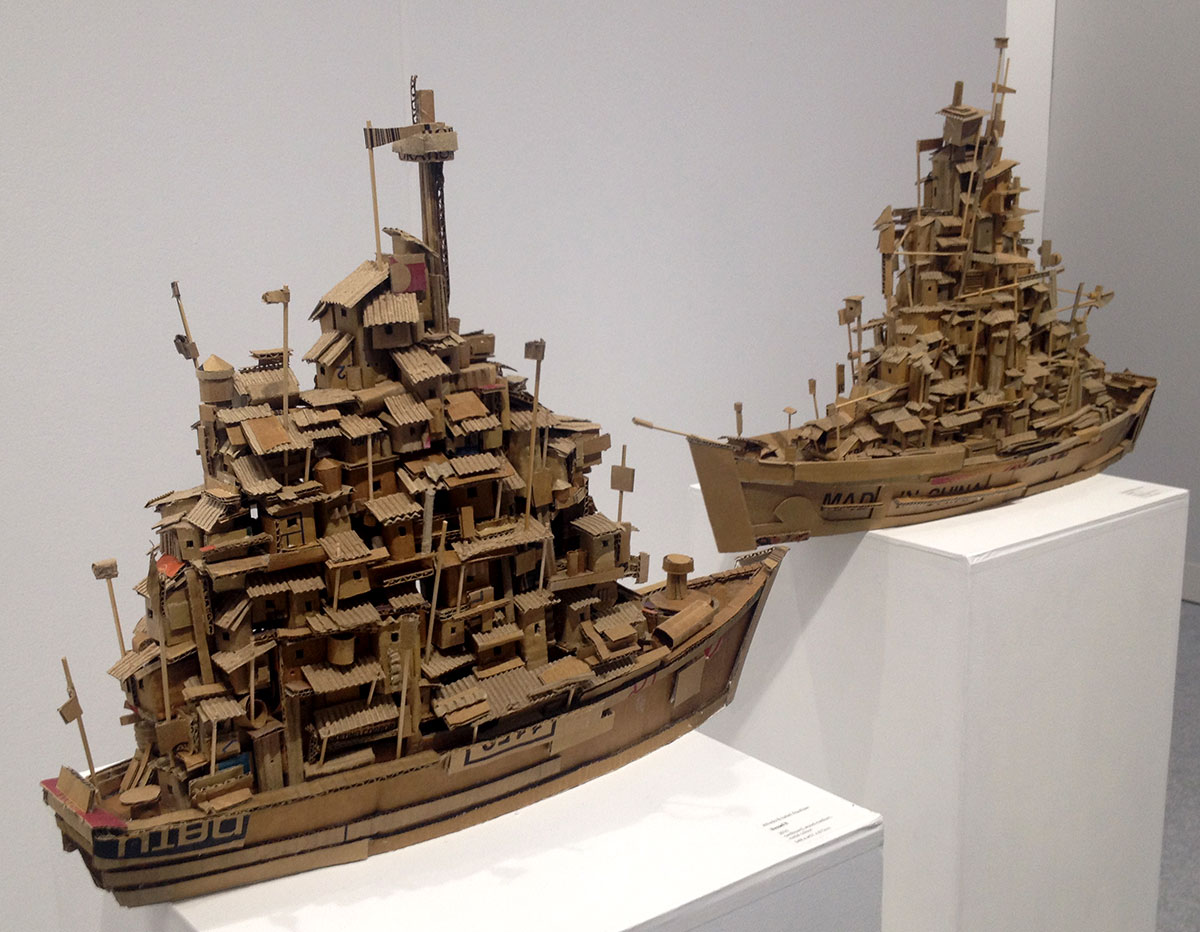
from Alfredo and Isabel Aquilizan’s cardboard boats
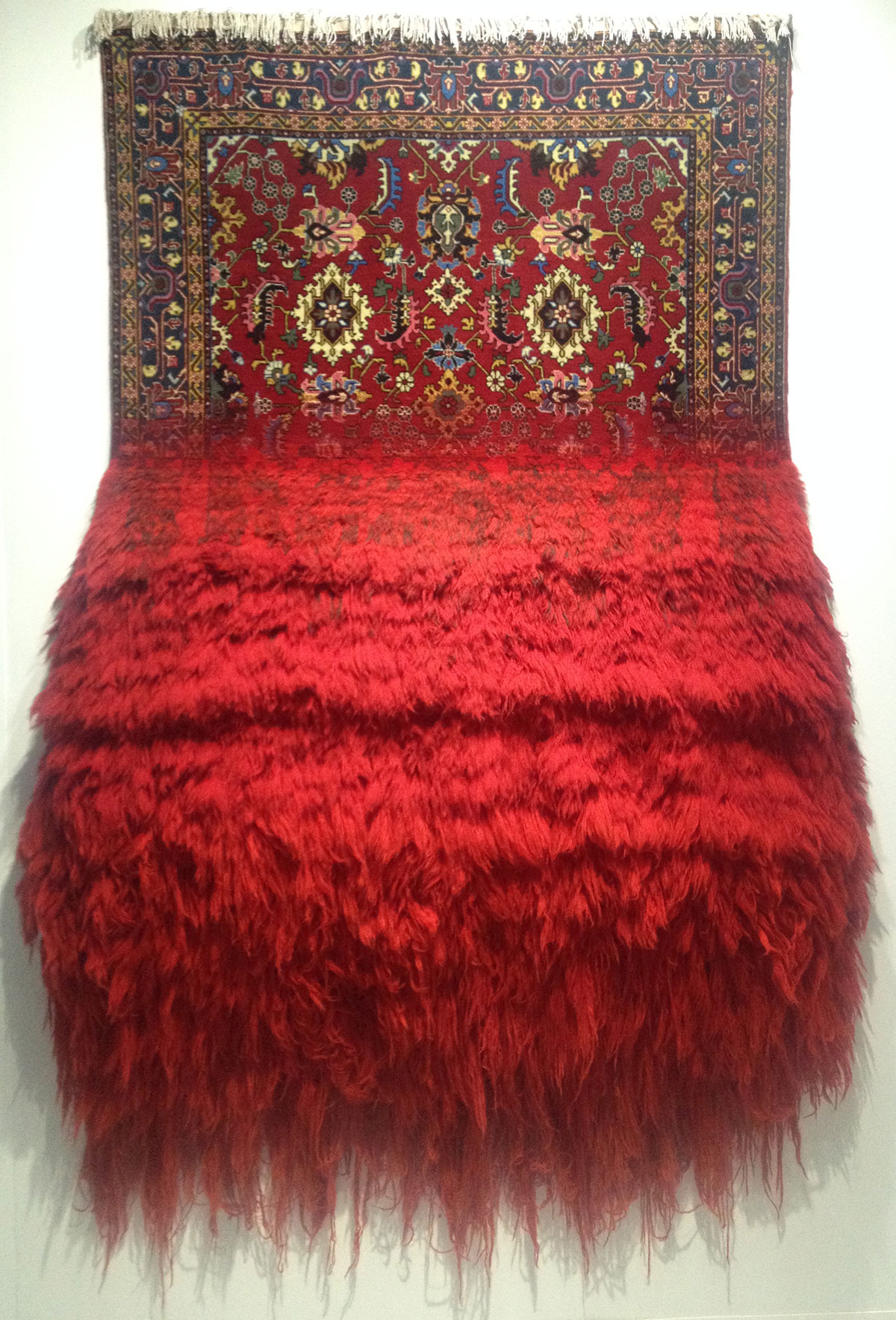
from Faig Ahmed’s beautiful hand made carpet pieces
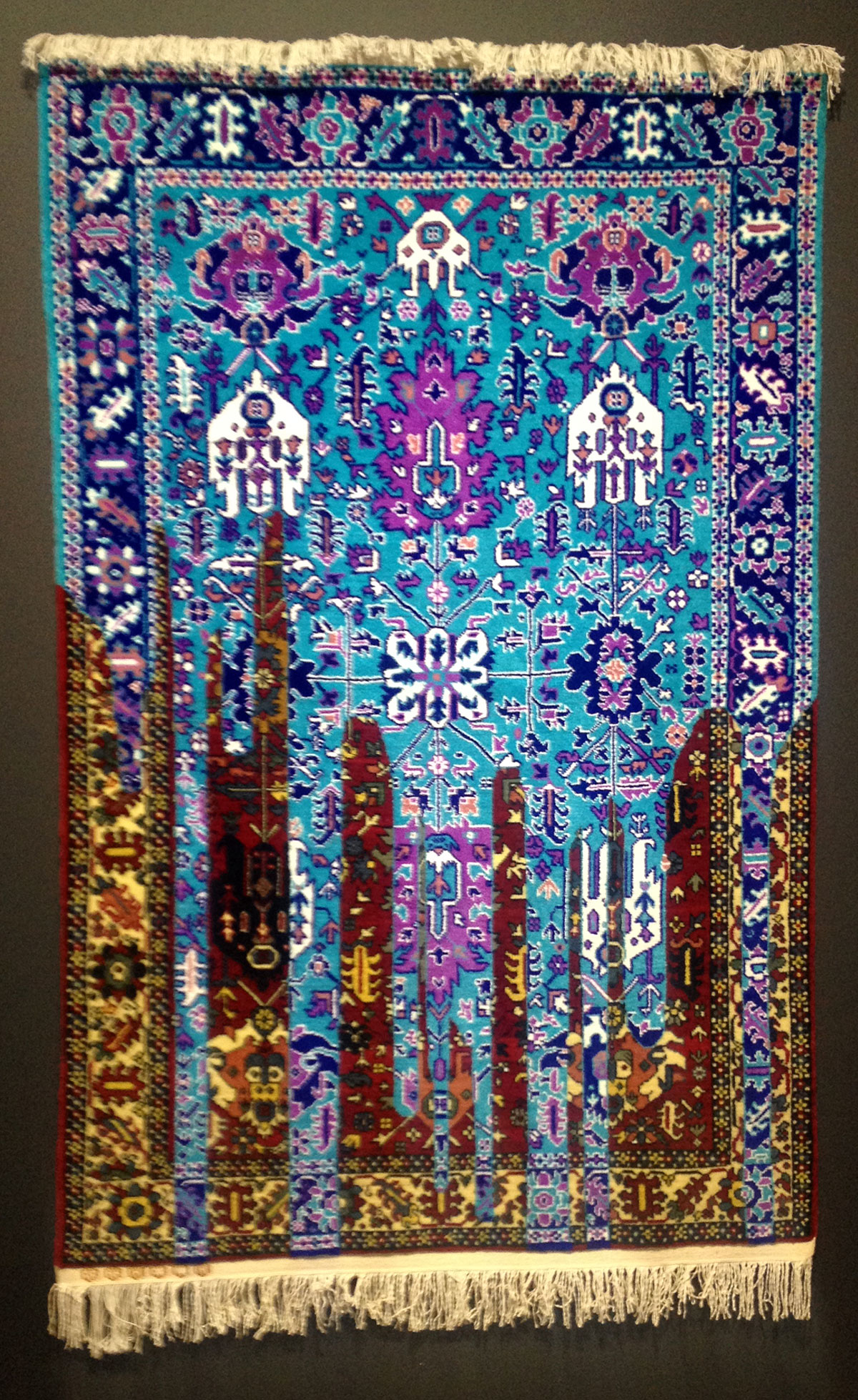
from Faig Ahmed’s beautiful hand made carpet pieces
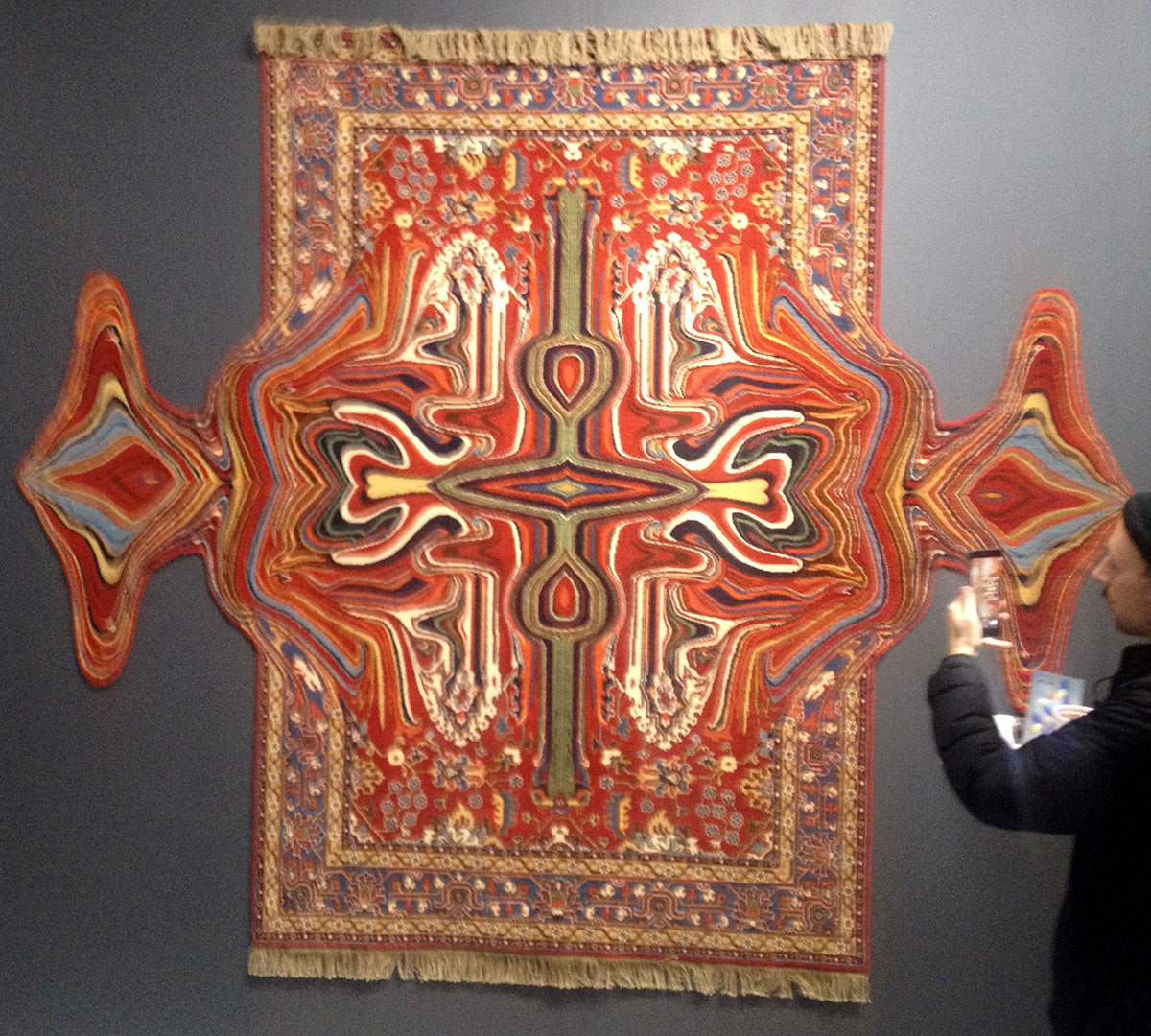
from Faig Ahmed’s beautiful hand made carpet pieces

from Federico Solmi’s awesome animations
Kelly Sears’s Animations During Trump Administration
Animator Kelly Sears creates eerie speculative narratives by superimposing a voice on to archival footage. The voice presents a state of surveillance and authoritarianism as the viewer watches post-war American footage that she manipulates through various forms of animation. Sears’s work has even greater resonance and seems increasingly foreboding given the Trumpian political climate.
Although “The Rancher” (2012) uses footage of Lyndon B. Johnson, upon listening to the narration, Trump immediately comes to mind.
The Rancher (excerpt) from Kelly Sears on Vimeo.
“Voice on the Line” (2009) stirs to mind the NSA’s wiretapping, but again with Trump’s assault on immigrants and initial legislative actions, the Trump administration and ICE come to mind as I watch excerpts from this film in which a secret police listen to conversations with phone operators. Unknowingly the operators have become complicit in the monitoring and spying of the U.S. population.
Voice on the Line (excerpt) from Kelly Sears on Vimeo.

